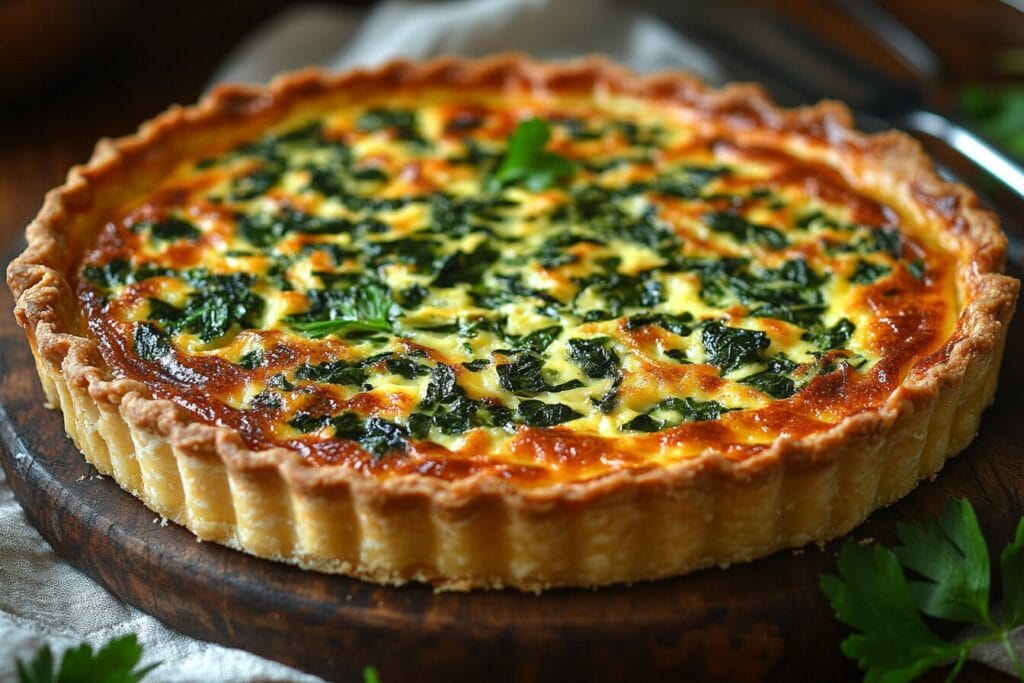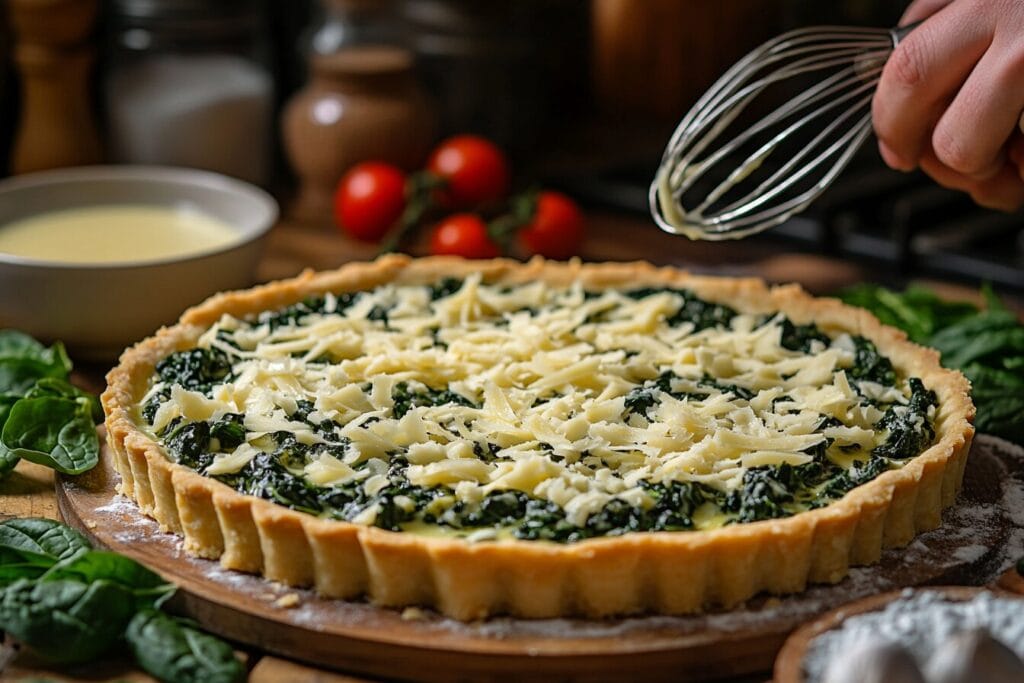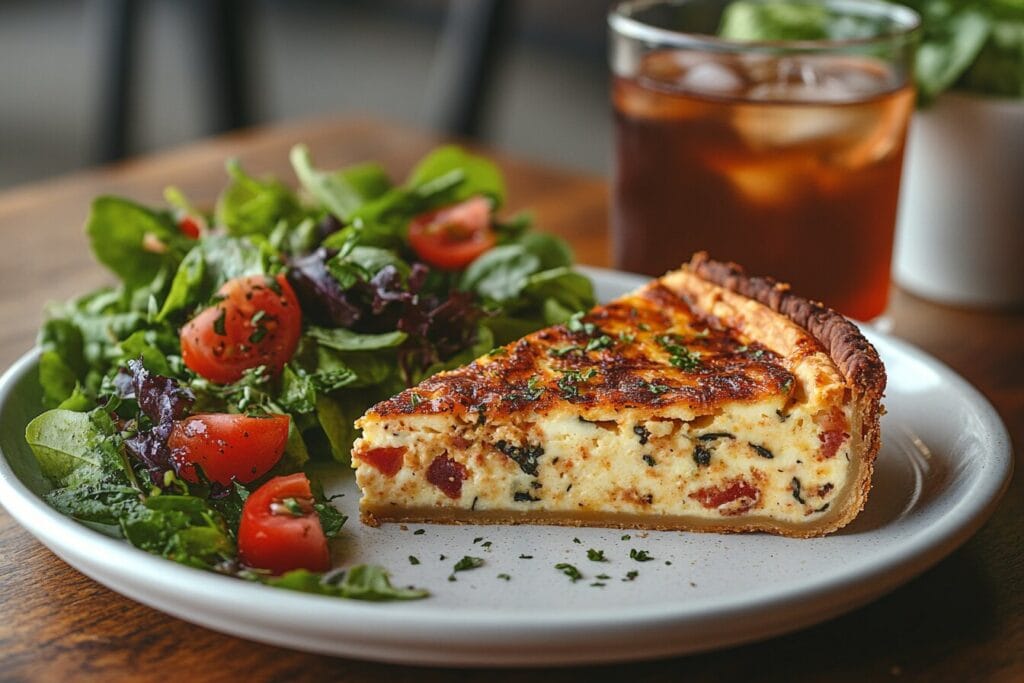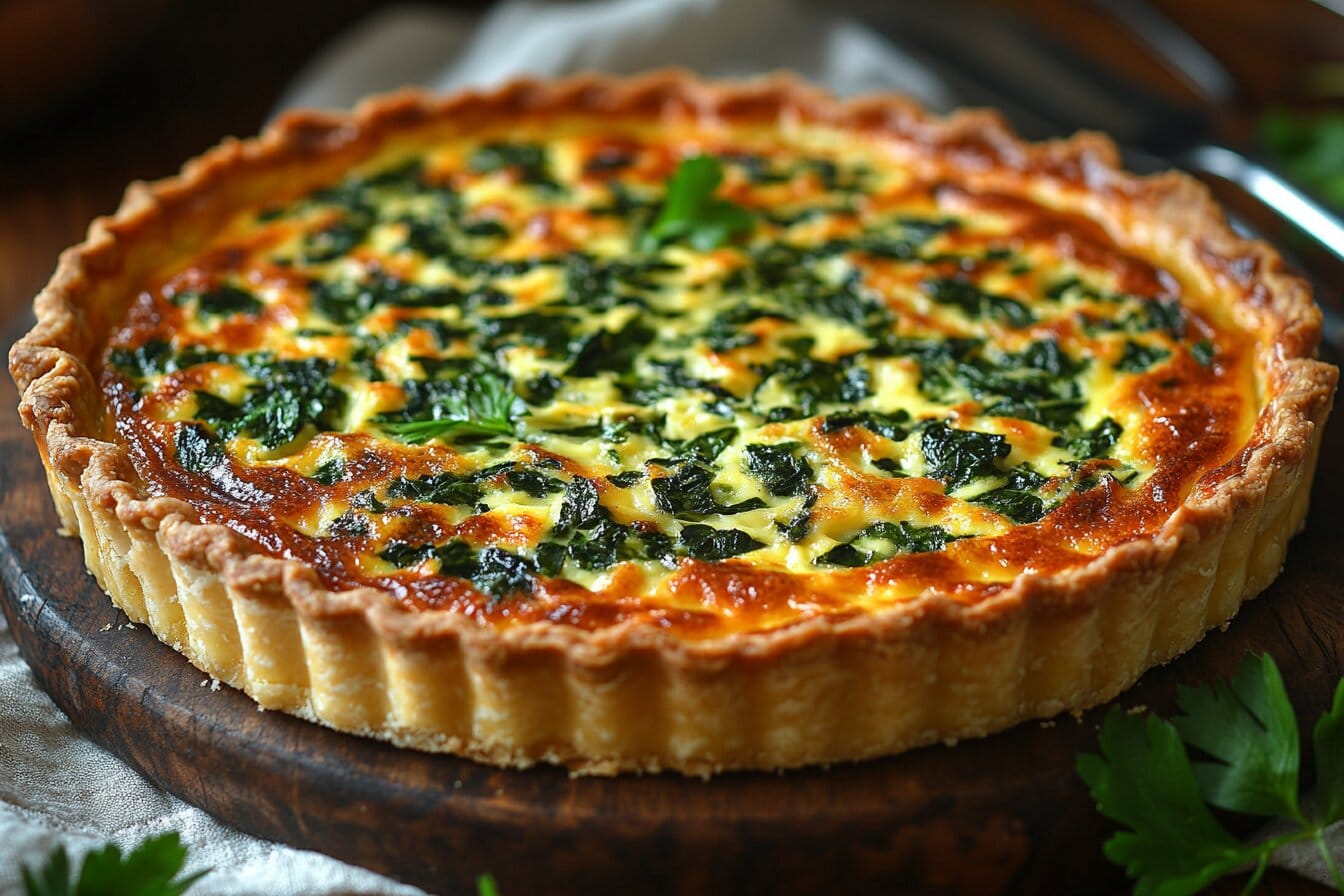Introduction
Quiche Florentine is a savory pie that combines the richness of a classic quiche with the simplicity and elegance of Florentine-style cooking, which emphasizes the use of fresh spinach. This French-inspired dish is perfect for brunches, lunches, or even light dinners, offering a balance of flavors and textures that appeal to nearly every palate. With its flaky crust, creamy filling, and vibrant green spinach, Quiche Florentine is not only a feast for the taste buds but also for the eyes.
The term “Florentine” often refers to dishes prepared with spinach, a tradition tracing back to Catherine de’ Medici, an Italian queen of France who popularized spinach in French cuisine during the Renaissance. Quiche, on the other hand, has its roots in the Alsace-Lorraine region of France. Combining these two culinary traditions gives us Quiche Florentine—a dish that embodies sophistication and simplicity.
This article will take you through everything you need to know about Quiche Florentine, from its history and ingredients to expert tips for achieving the perfect texture and flavor. Whether you’re a seasoned chef or a home cook looking for a new recipe to try, this guide will provide all the details you need to create a masterpiece.

Understanding Quiche Florentine
Quiche Florentine is a quintessential dish that marries French culinary traditions with the wholesome appeal of spinach. To fully appreciate its flavors and charm, it’s important to understand its core components and how they come together to create this delightful recipe.
Key Ingredients That Define the Dish
At its heart, Quiche Florentine consists of a delicate pastry crust filled with a mixture of eggs, cream, cheese, and spinach. Each of these ingredients plays a vital role in the dish’s texture and taste:
- Pastry Crust: The crust serves as the foundation of the quiche, providing a buttery and flaky base that contrasts beautifully with the creamy filling.
- Eggs and Cream: These form the custard that holds the filling together. The eggs provide structure, while the cream adds richness and a silky texture.
- Spinach: As the star ingredient, spinach contributes a fresh, earthy flavor and vibrant color. It’s a classic nod to the Florentine cooking tradition.
- Cheese: Gruyère or Swiss cheese is often used for its nutty flavor, but other varieties like cheddar or Parmesan can also work well.
- Seasonings: A pinch of salt, pepper, and nutmeg enhances the overall flavor profile, complementing the other ingredients.
The Role of Spinach and Cheese in the Recipe
Spinach and cheese are the defining elements that give Quiche Florentine its character:
- Spinach: This leafy green is not only rich in vitamins and minerals but also offers a subtle sweetness that balances the richness of the custard. Fresh spinach is commonly used for its bright flavor, though frozen spinach can be a convenient alternative when properly drained.
- Cheese: The choice of cheese can greatly influence the flavor of the quiche. Gruyère is a traditional favorite for its smooth melting quality and savory taste. For a twist, you can experiment with feta for a tangy kick or mozzarella for a milder profile.
These two ingredients, when combined with the custard and baked in a buttery crust, create a harmonious blend of flavors and textures that define Quiche Florentine.
A Perfect Dish for Any Occasion
Quiche Florentine is celebrated for its versatility. It can be served hot or cold, making it ideal for various occasions. Here are a few examples:
- Brunch Favorite: Paired with a side salad or fresh fruit, Quiche Florentine makes for an elegant brunch centerpiece.
- Picnic Delight: Its sturdy crust and hearty filling make it easy to transport, perfect for outdoor gatherings.
- Light Dinner: When paired with a soup or roasted vegetables, it serves as a satisfying yet light evening meal.
Understanding the essential components of Quiche Florentine not only helps in appreciating its taste but also inspires creativity when making your own variations.
The Perfect Ingredients
To create a Quiche Florentine that is both visually stunning and delicious, selecting high-quality ingredients is paramount. Each component contributes to the overall taste and texture, so paying attention to their quality and preparation is key.
Choosing the Best Pastry Crust
The crust serves as the structural base of Quiche Florentine, and getting it right is crucial for a satisfying dish.
- Homemade vs. Store-Bought: While a store-bought crust can save time, a homemade pastry crust offers unbeatable freshness and flakiness. A classic pâte brisée (French shortcrust pastry) is ideal for quiche.
- Flour Type: Use all-purpose flour for a tender crust or pastry flour for a more delicate texture.
- Butter or Shortening: Butter provides a rich flavor and helps create flaky layers, while shortening adds stability. A combination of both can yield the best results.
- Chilling the Dough: Chilling the dough before rolling prevents shrinking during baking and ensures a crispy texture.
- Blind Baking: Pre-baking the crust (with pie weights) ensures it stays crisp and doesn’t become soggy when the filling is added.
Fresh Spinach vs. Frozen Spinach: Which is Better?
Spinach is the heart of Quiche Florentine, and the choice between fresh and frozen depends on convenience and personal preference.
- Fresh Spinach: Offers a vibrant color and fresh taste. Be sure to sauté it lightly to reduce its moisture content before adding it to the quiche.
- Frozen Spinach: Convenient and cost-effective, but must be thawed and thoroughly drained. For guidance, visit Can I Substitute Canned Spinach for Fresh Spinach?.
- Volume Considerations: Keep in mind that fresh spinach wilts significantly during cooking, so you’ll need a larger initial volume compared to frozen spinach.
The Role of Dairy and Eggs in the Filling
The custard filling is the heart of any quiche, and Quiche Florentine is no exceptio
Selecting the Ideal Cheese
Cheese not only adds flavor but also contributes to the texture and richness of Quiche Florentine.
- Gruyère: The traditional choice, known for its nutty flavor and excellent melting qualities.
- Swiss Cheese: A milder alternative that melts well and complements spinach without overpowering it.
- Parmesan: Adds a sharp, tangy note when sprinkled on top before baking.
- Customization: For a unique twist, consider using goat cheese, feta, or even a blend of cheeses to create your preferred flavor profile.
Essential Seasonings and Add-Ins
Although Quiche Florentine is simple by nature, subtle seasonings enhance its flavor:
- Salt and Pepper: Essential for balancing the flavors in the custard and spinach.
- Nutmeg: A classic addition that brings depth to the dish.
- Garlic or Shallots: Sautéing these with spinach can add an extra layer of flavor.
- Optional Add-Ins: Mushrooms, sun-dried tomatoes, or artichokes can elevate the dish while keeping it vegetarian-friendly.
With your ingredients perfectly selected, it’s time to dive into the techniques that ensure your Quiche Florentine is a flawless masterpiece.
Cooking Techniques
Mastering the art of Quiche Florentine requires attention to detail, especially when it comes to crafting a flaky crust and achieving a creamy, well-set filling. Here’s how to perfect these techniques and create a quiche that’s a showstopper every time.
How to Achieve the Perfect Crust: Tips and Tricks
A great crust is the foundation of an exceptional quiche. Follow these steps to ensure yours turns out golden and crisp:
- Keep Ingredients Cold: Start with cold butter, cold water, and cold hands. The temperature is crucial for creating those flaky layers.
- Don’t Overmix: Mix the dough just until it comes together. Overmixing can lead to a tough crust.
- Roll Evenly: Use a rolling pin to spread the dough to an even thickness of about 1/8 inch. This ensures uniform baking.
- Blind Bake with Weights: Before adding the filling, pre-bake the crust. Line it with parchment paper or foil and fill it with pie weights or dried beans to prevent puffing.
- Cool Before Filling: Allow the crust to cool after blind baking to avoid a soggy bottom when the custard is added.
Ensuring a Creamy, Well-Set Filling
The filling is the centerpiece of Quiche Florentine. Balancing its texture and consistency is key:
- Beat Eggs Gently: Overbeating can introduce too much air, causing the filling to rise unevenly and then collapse. Whisk just until combined.
- Cream-to-Egg Ratio: For a custard that’s creamy but holds its shape, a good ratio is one egg for every 1/3 cup of cream or milk.
- Layer Ingredients: Spread spinach, cheese, and other add-ins evenly in the crust before pouring in the custard to ensure even distribution.
- Bake at the Right Temperature: Bake the quiche at 350°F (175°C). This moderate temperature allows the custard to set without overcooking.
- Monitor the Edges: If the crust edges brown too quickly, cover them with a strip of foil or a pie crust shield.
Balancing Moisture in the Filling
Spinach and dairy can introduce excess moisture, so managing it is critical:
- Sauté Spinach Thoroughly: If using fresh spinach, cook it until all the moisture has evaporated. For frozen spinach, squeeze out as much water as possible after thawing.
- Avoid Overloading the Filling: Too many watery add-ins like tomatoes or mushrooms can compromise the quiche’s structure. Always pre-cook and drain these ingredients.
- Thicken with Cheese: Cheese acts as a binder and absorbs some of the excess liquid from the filling, adding both flavor and texture.
Testing for Doneness
It’s important to know when your quiche is perfectly cooked:
- Visual Cues: The edges should be set, and the center should jiggle slightly but not slosh when shaken.
- Toothpick Test: Insert a toothpick or knife near the center. If it comes out mostly clean, the quiche is ready.
- Residual Cooking: Remove the quiche from the oven slightly underdone as it will continue to set while cooling.
Presentation Tips for a Stunning Quiche
Finally, ensure your Quiche Florentine looks as good as it tastes:
- Smooth Top: Spread the filling evenly to avoid lumps or uneven baking.
- Golden Crust: Brush the crust edges with an egg wash before baking for a glossy finish.
- Garnish: Add a sprinkle of fresh herbs like parsley or chives on top for a touch of color and elegance.
With these techniques, you’re well-equipped to create a perfectly cooked Quiche Florentine that will impress every time.
Step-by-Step Recipe
Making Quiche Florentine is a rewarding process that combines simple ingredients with expert techniques. Follow this detailed recipe to create a delicious and visually stunning dish.

Preparing the Crust
- Ingredients for the Crust:
- 1 1/4 cups all-purpose flour
- 1/2 cup (1 stick) cold unsalted butter, diced
- 1/4 teaspoon salt
- 3–4 tablespoons ice-cold water
- Instructions:
- Combine Dry Ingredients: In a large bowl, mix the flour and salt.
- Cut in Butter: Add the cold, diced butter and use a pastry cutter or your fingers to work it into the flour until the mixture resembles coarse crumbs.
- Add Water Gradually: Stir in ice-cold water, one tablespoon at a time, just until the dough comes together. Be careful not to overmix.
- Chill the Dough: Shape the dough into a disk, wrap it in plastic, and refrigerate for at least 30 minutes.
- Roll and Fit: Roll the dough out on a floured surface to about 1/8-inch thickness, then press it into a 9-inch tart or pie pan.
- Blind Bake: Line the crust with parchment paper, add pie weights, and bake at 375°F (190°C) for 15 minutes. Remove the weights and bake for another 5 minutes until lightly golden. Let it cool.
Making the Florentine Filling
- Ingredients for the Filling:
- 2 cups fresh spinach (or 1 cup frozen spinach, thawed and drained)
- 1 tablespoon olive oil or butter
- 1/2 cup diced onion or shallots
- 3 large eggs
- 1 1/2 cups heavy cream or whole milk
- 1 cup shredded Gruyère or Swiss cheese
- 1/4 teaspoon nutmeg
- Salt and pepper to taste
- Instructions:
- Cook Spinach: Heat olive oil or butter in a skillet over medium heat. Add spinach and sauté until wilted (or thoroughly heated if using frozen). Transfer to a colander and press out excess liquid.
- Sauté Aromatics: In the same skillet, sauté the diced onion or shallots until translucent, about 3 minutes.
- Prepare Custard: In a large bowl, whisk together eggs, cream, nutmeg, salt, and pepper.
Assembling and Baking the Quiche
- Assemble the Quiche:
- Layer the Ingredients: Spread the cooked spinach and onions evenly over the bottom of the cooled crust. Sprinkle the shredded cheese on top.
- Pour the Custard: Slowly pour the egg and cream mixture over the filling, ensuring it spreads evenly.
- Bake the Quiche:
- Place the quiche on a baking sheet and bake at 350°F (175°C) for 35–40 minutes, or until the filling is set and the center jiggles slightly when gently shaken.
- If the edges of the crust brown too quickly, cover them with a strip of foil.
- Cool and Serve:
- Let the quiche cool for 10–15 minutes before slicing to allow the filling to set completely.
- Serve warm or at room temperature with a fresh salad or crusty bread.
Customizing the Recipe
- Adding Protein:
- Cooked and crumbled bacon, diced ham, or smoked salmon can be added for a non-vegetarian twist.
- Vegetarian Add-Ins:
- Mushrooms, artichoke hearts, or sun-dried tomatoes can complement the spinach and cheese.
- Cheese Variations:
- Experiment with feta, goat cheese, or a blend of cheddar and mozzarella for different flavor profiles.
Tips for Variations and Pairings
Quiche Florentine is a versatile dish that can be adapted to suit various dietary preferences and flavor profiles. Let’s explore creative variations and the best pairings to elevate your meal.

Adding Protein for Extra Flavor
While Quiche Florentine is traditionally vegetarian, incorporating protein can add a savory depth to the dish:
- Bacon or Ham:
- Crisped bacon bits or diced ham complement the creamy filling and add a smoky flavor.
- Sprinkle the cooked meat evenly over the spinach before adding the custard.
- Smoked Salmon:
- Thinly sliced smoked salmon pairs wonderfully with spinach and Gruyère.
- Add it in small amounts to avoid overpowering the quiche.
- Chicken or Turkey:
- Shredded cooked chicken or turkey works as a hearty, protein-packed addition.
- Season lightly to match the quiche’s delicate flavors.
Vegetarian Additions for a Creative Twist
For those looking to keep the dish vegetarian, here are some excellent add-ins:
- Mushrooms:
- Sautéed mushrooms add an earthy, umami flavor. Opt for varieties like cremini, button, or shiitake.
- Artichoke Hearts:
- Chopped artichoke hearts lend a tangy and slightly nutty taste that enhances the filling.
- Sun-Dried Tomatoes:
- These provide a burst of concentrated sweetness and a chewy texture.
- Zucchini or Bell Peppers:
- Thinly sliced zucchini or diced roasted bell peppers add color and subtle flavor.
Gluten-Free and Vegan Alternatives
- Gluten-Free Crust:
- Substitute the traditional pastry crust with a gluten-free alternative, such as a rice flour crust or a crust made from almond meal.
- Pre-made gluten-free crusts are also available for convenience.
- Vegan Version:
- Use plant-based cream (e.g., almond or coconut milk) and a flaxseed or tofu substitute for eggs.
- Swap the cheese for a dairy-free alternative, such as nutritional yeast or vegan cheese.
Best Side Dishes to Serve with Quiche Florentine
Pair your quiche with complementary sides for a complete meal:
- Salads:
- Mixed Greens with Lemon Vinaigrette: The freshness of greens and a tangy vinaigrette balance the richness of the quiche.
- Caprese Salad: A simple mix of tomatoes, mozzarella, basil, and balsamic glaze pairs well with the creamy filling.
- Soups:
- Tomato Basil Soup: The acidity of tomato soup enhances the creamy texture of the quiche.
- Butternut Squash Soup: A mildly sweet, velvety soup makes a comforting pairing.
- Breads and Pastries:
- Crusty French Baguette: Perfect for sopping up every last bite of the filling.
- Herb-Infused Focaccia: A flavorful option that complements the dish’s rustic charm.
Storing and Reheating Quiche Florentine
Proper storage and reheating ensure your quiche remains just as delicious the next day:
- Storage:
- Cool the quiche completely before storing.
- Wrap it tightly in plastic wrap or aluminum foil and refrigerate for up to 3 days.
- For longer storage, freeze individual slices in airtight containers for up to 2 months.
- Reheating:
- Reheat slices in a 350°F (175°C) oven for 10–15 minutes to restore their texture and flavor.
- Avoid microwaving, as it can make the crust soggy.
Making Quiche Florentine a Showstopper
- Garnish: Top with fresh herbs like chives, parsley, or dill for a pop of color and added aroma.
- Presentation: Serve on elegant plates with vibrant garnishes to elevate the dish’s appeal.
- Customization: Encourage guests to choose their add-ins or toppings for a personalized quiche experience.
Learn how these ingredients can complement spinach in our article Is It Good to Eat Chicken with Spinach?.
FAQ
What is Quiche Florentine made of?
Quiche Florentine is a savory pie made with a buttery pastry crust filled with a rich custard mixture of eggs, cream, and cheese, combined with spinach as the key ingredient. Traditional recipes often include Gruyère or Swiss cheese for its nutty flavor, but variations can use other cheeses like Parmesan or feta. Seasonings like nutmeg, salt, and pepper are added to enhance the dish’s flavor. The filling is baked until creamy and set, resulting in a delicious and visually appealing dish.Quiche Florentine is a savory pie made with a pastry crust filled with custard, cheese, and spinach.
For an in-depth look at the ingredients, visit What is Quiche Florentine Made Of?.
What’s the difference between quiche and Quiche Lorraine?
The primary difference lies in the ingredients. Quiche Lorraine, a classic French dish, is traditionally made with bacon or lardons and does not include vegetables. The filling is a combination of eggs, cream, and sometimes cheese, but the focus is on the savory meat. Quiche Florentine, on the other hand, highlights spinach as the main ingredient and is typically vegetarian, featuring cheese and custard without any meat. Both quiches share the same custard-based filling and flaky crust, but their flavor profiles and ingredients set them apart.
Are Florentines French or Italian?
Florentines are traditionally associated with Italian cuisine, specifically the Tuscan city of Florence. The term “Florentine” refers to dishes made in the style of Florence, which often feature spinach as a key ingredient. This culinary influence was introduced to French cuisine by Catherine de’ Medici, an Italian queen of France during the Renaissance. Dishes like Quiche Florentine reflect this blend of Italian and French culinary traditions, showcasing spinach as a signature element.
Is quiche healthy or unhealthy?
Quiche can be both healthy and indulgent, depending on the ingredients and portion sizes. On the healthy side, Quiche Florentine features spinach, which is rich in vitamins A, C, and K, as well as iron and fiber. However, the dish’s high fat content comes from cream, cheese, and butter used in the crust and filling. To make quiche healthier, you can use low-fat dairy, reduce the amount of cheese, or swap the crust for a gluten-free or whole-grain alternative. In moderation, Quiche Florentine can be part of a balanced diet, especially when paired with fresh vegetables or a salad.
Conclusion
Quiche Florentine is a timeless dish that exemplifies the beauty of simple yet sophisticated cuisine. With its buttery crust, creamy custard, and vibrant spinach filling, this French-inspired recipe is a versatile choice for any meal. Whether enjoyed at a brunch gathering, as a light dinner, or packed for a picnic, Quiche Florentine is sure to impress with its rich flavor and elegant presentation.
Rooted in both Italian and French culinary traditions, this dish celebrates the harmony of fresh ingredients and thoughtful preparation. Its adaptability allows for endless variations, from adding proteins like bacon or smoked salmon to experimenting with vegan or gluten-free alternatives. Paired with the right sides and beverages, Quiche Florentine becomes a complete meal that appeals to a wide range of tastes and dietary needs.
Incorporating Quiche Florentine into your repertoire not only enriches your cooking experience but also offers a delightful way to enjoy the nutritional benefits of spinach. Whether you’re hosting guests or treating yourself, this dish promises to be a standout centerpiece that never fails to deliver.

